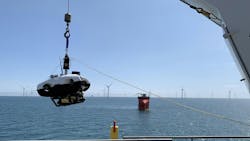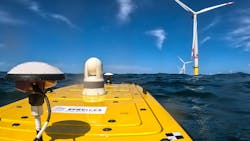German wind farm pilot project validates autonomous marine data acquisition technologies
Editor's note: This feature article first appeared in the November-December 2023 issue of Offshore magazine. Click here to view the full issue.
By Sören Themann, Subsea Europe Services
Offshore energy companies and their contractors share a common demand for detailed information spanning large areas and extending across several years. This wealth of marine data serves as the bedrock upon which they build business strategies, invest billions of dollars in offshore and subsea infrastructure, and safeguard invaluable assets. Such data is just as critical for optimizing operations and mitigating risks as well as unlocking new sustainable workflows at all stages of an offshore wind farm’s lifecycle, from planning, development, and operations and maintenance (O&M) through to decommissioning.
Traditionally, the acquisition and analysis of marine data have relied heavily on crewed vessels and human data analysts, a method characterized by its inherent costs and resource intensiveness. Though effective, the traditional approach has only scratched the surface of the vast potential hidden within the depths of the oceans, but new autonomous technologies are catalyzing a shift towards unlocking the full value of marine data. By enabling lower-cost access to much more available data, these advanced surface and subsurface data acquisition platforms and subsequent digital, cloud-based workflows have the potential to revolutionize the way the offshore industry operates, paving the way for a future where data becomes the key to sustainable, secure, and efficient offshore development and production.
The potential of autonomous data acquisition was demonstrated in July 2023 for the first time on an operational wind farm, in a pilot project delivered by Germany’s Subsea Europe Services and its partners MARTAC Systems and BeeX for Canadian renewable energy company, Northland Power. The two-week mission took place at the Northland Power owned Deutsche Bucht offshore wind farm, located 95 km west of Borkum in the German Exclusive Economic Zone. Deutsche Bucht has an operating capacity of 252 MW, meeting the annual energy needs of 300,000 people and reducing the annual CO2 emissions of Germany by 700,000 tons.
Mothership concept
The July 2023 project was commissioned to verify performance and further develop the operational workflows of Subsea Europe Services’ MARTAC Systems manufactured Autonomous Surveyor USV (uncrewed surface vessel) for multibeam surveying, and the BeeX designed and built A.IKANBILIS Hovering AUV (HAUV). The focus was on bathymetric surveys and subsea inspections such as scour and marine growth surveys using the platforms based on or deployed from a service operations vessel (SOV) mothership already resident for O&M at the wind farm. Operational objectives included data acquisition from the wind turbine generators and offshore substations as well as inter-array cables, cathodic protection and cable protection systems.
The USV’s missions started from the SOV using a prototype launch and recovery system developed by Subsea Europe Services R&D department. The team has gone through several iterations to ensure safe nearby operations while optimizing the process of getting the Autonomous Surveyor off and back on the ship within minutes. The experience highlighted further areas for improvement, especially for launch and recovery in stronger currents, which the R&D team are working on to ensure even more efficient launch and recovery going forward. Once in the water, the Autonomous Surveyor followed its mission plan to survey the foundations and the inter-array cabling for scour and exposure using an integrated Sonic 2024 Multibeam Echo Sounder from R2Sonic, which is usually deployed from large, crewed survey vessels.
Freedom of movement
Meanwhile, below the surface, the A.IKANBILIS HAUV conducted comprehensive visual inspections of the underwater components of wind turbine generators, encompassing surveys of scour, cables, cathodic protections, and a marine growth assessment. Beyond addressing logistical challenges inherent in wind farm O&M, the project underscored the HAUV’s capabilities. Blending the strengths of ROVs and AUVs, it can operate untethered, granting high underwater mobility and autonomy.
Significantly, the team found that A.IKANBILIS excelled in keeping position even in challenging currents, maintaining its ability to deliver high-quality, stabilized imagery with no human intervention required post-deployment, thanks to its HD camera optimized for low-light conditions and a potent 4300 lumens lighting system. Throughout the project, the HAUV demonstrated capabilities not available using similar-sized standard ROVs, with computer-controlled flights, integrated sensor data, and real-time visualization enhancing productivity and expanding operational horizons.
Approved data quality
With the lower deployment costs compared to work-class ROVs and superior underwater capabilities, the pilot showed that HAUV technology may be ready to challenge the dominance of ROVs in underwater inspections for wind farm O&M operators. Further, the data acquired by A.IKANBILIS and Autonomous Surveyor during the pilot project was accepted by the client and BSH, Germany’s Federal Maritime and Hydrographic Agency, showing that both surface and subsea platforms can match the baseline quality of crewed and remotely operated solutions.
The pilot project has uncovered several benefits of integrating new data acquisition workflows into offshore wind farms. This includes leveraging pre-existing vessels like the Albert Betz SOV as motherships for autonomous platforms. The USV and HAUV for marine surveying and underwater inspections blended in well with the overall operations of the SOV, demonstrating that the ‘mothership concept’ works in a live scenario.
The project revealed that relocating a single technician per shift to motherships equipped with multiple uncrewed surface vessels, while the marine surveyors stay in onshore operations centers, yields a substantial reduction in operational expenditures. Furthermore, the expanding offshore wind industry is poised to create a scarcity of qualified surveyors, making autonomous platforms a valuable resource to bridge this gap and enhance the industry's profitability and sustainability.
Additionally, substantial cost savings can be realized in various aspects of utilizing USVs. These uncrewed platforms are notably more cost-effective to construct compared to crewed vessels, which must accommodate human personnel. USVs are inherently smaller, highly agile, and require simpler maintenance. Moreover, their economic viability allows for the integration of innovative electric propulsion solutions, capable of significantly reducing fuel costs and achieving 100% carbon neutrality when coupled with renewable energy sources for battery charging.
Finally, expanding the capacity of a fleet of USVs is more cost-efficient than using crewed survey vessels, making it possible to conduct swarm surveys from a single mothership that can acquire more data, much faster. This approach exponentially reduces the expenses associated with marine data, presenting a highly economical alternative to traditional methods.

